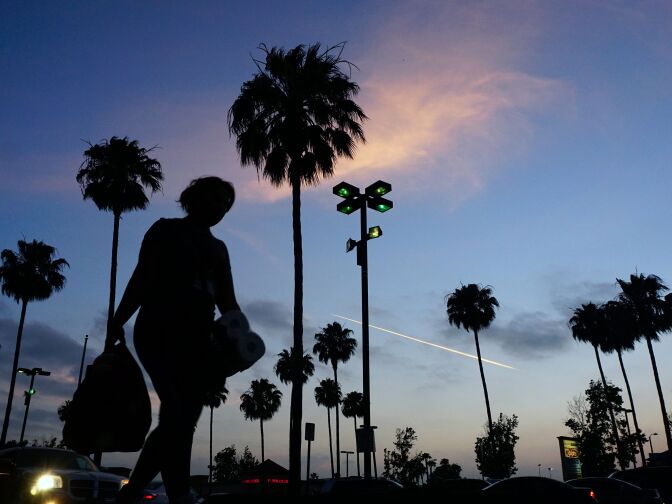With our free press under threat and federal funding for public media gone, your support matters more than ever. Help keep the LAist newsroom strong, become a monthly member or increase your support today.
Most urban trees in SoCal aren't from here. Why we need to replace them.
Most trees growing in urban Southern California aren’t a good fit for a climate-changed future.
So, what should we replace them with?

To answer that question, researchers with the US Forest Service and the UC Cooperative Extension planted test plots of drought-tolerant trees across Central and Southern California. They plan to monitor them for 20 years to see how well they grow.
What are they testing?
These aren’t species you’ve likely seen locally before. They include:
- Palo verde
- Mesquite
- Desert willow
- Osage orange
All thrive in hotter, drier places like Australia, New Mexico or Arizona. And that’s the point.
Scientists anticipate Southern California will be much more desert-like in the future.
What 2080 looks like
Consider these forecasts for days with the temperature 95 degrees or hotter by the year 2080:
- Riverside will experience 128 days over 95 degrees. Today it's 58 days.
- Long Beach will have 37. Now it's 4.
- Irvine will experience 35. It's now 3.
Those estimates come from climate researchers at UCLA. In addition to increased heat, precipitation is likely to become even more erratic, with droughts followed by flooding.
Many of the urban trees that are growing here now just aren’t accustomed to those conditions.
Why not?
That's because they were planted by people who moved to California from the Midwest and the East Coast, bringing their favorite trees with them.

“There is a whole palate of trees that came with the people, because the nursery men got trees imported from the Midwest and they began selling them,” said Greg McPherson, an urban forest researcher with the US Forest Service in Davis. “Ash trees, London planetrees, sycamores, sweet gums and maples.”
Those trees require a lot of water, McPherson said, something that just isn’t practical anymore in most of California. As those trees age and die, or are killed by invasive pests, he and his colleagues wanted to know what to replace them with.
Even today, urban foresters in Southern California aren’t necessarily planting drought and heat-tolerant species. A 2018 study of Claremont’s urban forest found that many dead trees were being replaced with tulip trees, which are native to the Southeast.
“What they were replacing them with was not well-suited. Because those species did not seem to be ones that were well-adapted to the types of stressors, the heat, the drought, the wind, the salinity, that trees will be facing in the future,” McPherson said.
What they're studying
McPherson and his colleagues selected 12 species of drought-tolerant trees, and planted 144 of them at six sites throughout inland and coastal California, from San Pedro to Riverside. They’re planning on monitoring them for the next twenty years to see which ones do best. Then they will introduce Southern Californians to those varieties.

“Unless people specifically request them, nurseries don’t want to carry them,” said Janet Hardin with UC Cooperative Extension in Riverside. “And people don’t ask because nurseries don’t carry them.”
Another goal of the study is to get people to plant more trees, period. McPherson found that cities aren’t planting as many trees as they used to, and aren’t replacing them with anything when they die. In the late 1980s, there were 105 trees per mile in California’s cities; today there are just 75.
But there are plenty of reasons to plant trees in cities: they already provide $1 billion in benefits to Californians, according to the US Forest Service, between capturing carbon dioxide, cleaning the air, catching rainfall and providing shade and cooling air temperatures, which reduces the need for air conditioning and lowers energy bills.
This story is part of Elemental: Covering Sustainability, a new multimedia collaboration between Cronkite News, Arizona PBS, KJZZ, KPCC, Rocky Mountain PBS and PBS SoCal.











